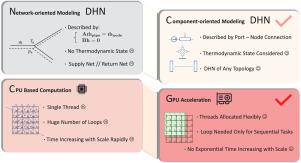Applied Energy ( IF 10.1 ) Pub Date : 2021-09-17 , DOI: 10.1016/j.apenergy.2021.117832 Zhang Chen 1 , Jun Liu 1, 2 , Xinglei Liu 1

|
Due to its advantage of improving energy efficiency and promoting sustainable development, integrated electricity and heat system (IEHS) has been widely studied in recent decades. However, the traditional network-oriented district heating network (DHN) model in IEHS could only deal with DHNs of supply-return-parallel topologies, and the employ of constant thermodynamic properties could incur inaccurate power flow results. With the increasing requirements on operation flexibility and system resilience of IEHS, it has become a necessity to develop a superior power flow model of DHN. This study presents a novel component-oriented modeling method in which the models of the three basic components in DHN, the pipelines, pressure sources and junctions, are investigated in detail. Formulas of the fundamental physical processes including pressure, temperature loss and enthalpy transfer are derived based on the variable thermodynamic state of the fluid rather than predetermined constants in the traditional simplified models. Variables associated with these basic components are discussed in detail and their respective constraints are expounded. To overcome the huge amount of computation in the IEHS analyzing process, GPU is introduced as a coprocessor and a parallel algorithm is designed accordingly. The versatility of the proposed model, including providing accurate, more detailed power flow results and analyzing DHN of general topologies, is presented in a small-scale DHN case. And the practicality of the proposed model is demonstrated in the ensuing practical-scale IEHS case. Meanwhile, the proposed GPU-based parallel algorithm has attained more than 3 times of performance boost compared to single CPU computing.
中文翻译:

基于面向组件的区域供热网络建模的热电联供系统的 GPU 加速潮流计算
由于电热一体化系统(IEHS)具有提高能源效率和促进可持续发展的优势,近几十年来得到了广泛的研究。然而,IEHS中传统的面向网络的区域供热网络(DHN)模型只能处理供回并联拓扑的区域供热网络,并且采用恒定的热力学特性可能会导致潮流结果不准确。随着 IEHS 对运行灵活性和系统弹性的要求越来越高,开发 DHN 的优越潮流模型已成为必要。本研究提出了一种新的面向组件的建模方法,其中详细研究了 DHN 中三个基本组件(管道、压力源和接头)的模型。基本物理过程的公式,包括压力、温度损失和焓传递是基于流体的可变热力学状态而不是传统简化模型中的预定常数得出的。详细讨论了与这些基本组件相关的变量,并阐述了它们各自的约束条件。针对IEHS分析过程中计算量巨大的问题,引入GPU作为协处理器,并相应设计了并行算法。在小规模 DHN 案例中展示了所提出模型的多功能性,包括提供准确、更详细的潮流结果和分析一般拓扑的 DHN。并且在随后的实际规模 IEHS 案例中证明了所提出模型的实用性。同时,











































 京公网安备 11010802027423号
京公网安备 11010802027423号